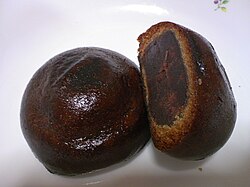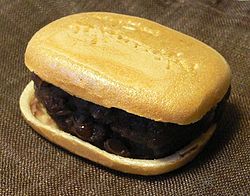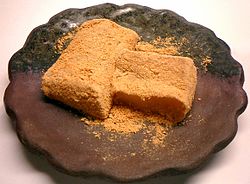
The Japanese had been making desserts for centuries before sugar was widely available in Japan. Many desserts commonly available in Japan can be traced back hundreds of years. [1] In Japanese cuisine, traditional sweets are known as wagashi , and are made using ingredients such as red bean paste and mochi. Though many desserts and sweets date back to the Edo period (1603–1867) and Meiji period (1868–1911), many modern-day sweets and desserts originating from Japan also exist.
Contents
- Japanese desserts
- Wagashi
- Types of wagashi
- Gallery
- Brands
- See also
- Japanese sweets and desserts
- Related topics
- References
- External links
However, the definition of wagashi is ambiguous, and the line between wagashi and other types of Japanese confectionery is vague. For example, although the original kasutera (castella) was introduced from Portugal, it has been around for more than 400 years and has been modified to suit Japanese tastes, so it is classified as a wagashi. [2] [3] [4] The raindrop cake, created in 2014, was developed by a wagashi shop as a derivative of shingen mochi and is recognized as a wagashi in Japan. [5] [6] In recent years, wagashi shop have developed and marketed many confections that are an eclectic mix of wagashi and Western confections, often referred to as "neo-wagashi". [7]
























